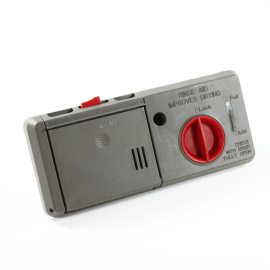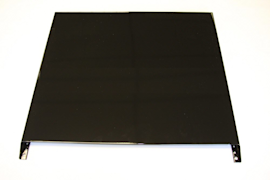Dishwasher not cleaning dishes video


If your dishwasher isn’t getting your dishes clean, the problem could be as simple as how you load the dishwasher, water that's not hot enough or old, ineffective detergent. Check out this Sears PartsDirect video for more tips on how to get your dishes looking clean and spotless.
Our Dishwasher DIY Repair section also has additional troubleshooting videos, repair guides, error code charts and answers to the most often asked questions about dishwasher problems. Once you've determined what needs to be fixed on your dishwasher, get the replacement parts you need at Sears PartsDirect.
Tools and parts needed
How to load a dishwasher
Hi, Wayne here from Sears PartsDirect. Today we're going to talk about what to do when your dishwasher doesn't clean your dishes well. First, let's cover some basics. Loading the dishes correctly helps the dishwasher clean them. Angle heavily soiled dish surfaces downward and leave enough room between the dishes to allow water to reach all sides. Make sure that spray arms spin freely after loading the dishwasher and don’t block the detergent dispenser lid.
Choose the correct cycle
After loading the dishes, select the correct cycle for the type of dishes that you're washing. A quick or normal wash cycle cleans most dishes well, but that cycle won't clean dirty pots and pans. Choose a heavy wash or a pots and pans cycle to clean really dirty cookware.
If your dishwasher has a high-temperature setting, choose it for better cleaning. The dishwasher will heat the water to higher temperatures, and do a better job of melting grease off dishes. It will also dissolve detergent better, improving cleaning performance.
Refer to your owner's manual for information about the cycles and options on your dishwasher.
Check the filters for clogs
Next, we'll talk about filters. Clogged filters interfere with water flow, which can cause poor cleaning performance. Remove and inspect your dishwasher filters monthly. You can clean the filters by holding them under running tap water.
Remove dirt or hard water deposits using a soft bristle brush. Scrub the filters whenever you see soil or residue building up on the screens or if dishes feel gritty and you see food particles after the cycle finishes.
If your filter is different, check your owner's manual to learn how to clean the filter on your model.
Check the spray arms for cracks and clogs
Next we’ll talk about spray arms. Dishes won't get clean if the dishwasher can’t spray them thoroughly with water. First, check the spray arms for cracks or damage. A cracked spray arm won't rotate and spray correctly. Replace the spray arm if it’s damaged.
If the spray arm isn’t cracked, check the spray arms for clogged openings. Hard water deposits and food debris can clog these holes. You can clear the holes with toothpicks or a bamboo skewer. For severe clogs, remove the spray arms following the instructions in the owner’s manual and clean them in the sink. Use a toothbrush and a bamboo skewer to remove clogs, and soak them in white vinegar to help remove hard water deposits. Rinse the spray arms thoroughly and reinstall them.
If hard water deposits frequently block your spray arm holes, we recommend cleaning your dishwasher once a month with Dishwasher Magic or Affresh dishwasher cleaner.
Make sure dishwasher fills with water
If your spray arms are okay, the next thing to check is the water level. Start a cycle with the dishwasher empty and allow the dishwasher to fill with water–which should take about 2 minutes. When you hear the water stop filling or the pump start running, you know the dishwasher is finished filling.
Open the dishwasher door slightly to stop the cycle. When the cycle stops, open the door fully and check the water level in the tub. The water level should be close to the bottom of the mushroom-shaped float. If your dishwasher isn’t filling, or the water level is far below the float, you’ve likely found the problem. Check out this video to see troubleshooting tips for a fill problem in your dishwasher.
Check the water temperature
If your water level is all right, let’s check your water temperature next. Your water must be at least 120 degrees to clean efficiently, even if you use the high-temperature cycle. To check the water temperature, run the hot water from your kitchen sink faucet for 1 minute and then fill a glass with hot water. Measure the water temperature in the glass using a cooking thermometer.
If the temperature is less than 120 degrees, carefully increase the temperature setting on your water heater. Make small, incremental increases and don't set your water heater temperature above 120 degrees. That should protect you from burns in the bath or shower.
Troubleshoot detergent problems
If your water supply temperature is all right, let's talk about some problems with your detergent that could cause poor cleaning. If the lid to the detergent dispenser lid is still closed after you run the dishwasher, here’s a link to a video with troubleshooting tips to resolve that problem.
Next, check the condition of your detergent. Old or stale dishwashing powder like this won't clean your dishes well because the detergent loses effectiveness and may leave gritty deposits on your dishes. It doesn't take long for powdered detergent to age if you store it under the damp sink. Toss out old, clumpy detergent and use only fresh, dry detergent for the best dishwashing results. Store powdered detergent in an upper cabinet where it stays dry and it will last longer.
Check water hardness
It’s also important to use the right amount of detergent based on your water hardness and the dirtiness of your dishes. If you don't know your water hardness, contact your water supplier or you can look it up online. If you want to check the water hardness yourself, you can use a test strip such as this one. You can also bring a water sample to your local Sears store and we'll check it for you for free.
Use rinse aid
Once you know the water hardness, follow the directions in your owner's manual to fill the dispenser with the right amount of detergent. Always use rinse aid in your dishwasher. Rinse aid reduces spots, which can make your dishes look dirty. Even if you use detergent tablets or pods that include rinse aid, you should still use liquid rinse aid. The rinse aid dispenser in your dishwasher dispenses the right amount during the final rinse cycle so your dishes turn out spotless. Pods and tablets may not release rinse aid at the right time.
Many rinse aid dispensers also have a setting that you should set based on your water hardness. Check your owner's manual and set the rinse aid dispenser in your dishwasher to the proper level. These tips should help you get your dishes looking clean and spotless.
I hope this video helped you out. You can find links to the products we talked about in the video description. Check out our other videos on the Sears PartsDirect YouTube channel. Subscribe and we’ll let you know when we post new ones.
Most common symptoms to help you fix your dishwashers
Choose a symptom to see related dishwasher repairs.
Main causes: broken door spring, damaged or broken door hinge…
Main causes: not using rinse aid, rinse aid dispenser failure, broken heating element, malfunctioning vent, drying fan f…
Main causes: water supply problem, stuck overfill float, clogged water inlet valve screen, water inlet valve failure…
Main causes: light switch beside the sink turned off, lack of power, bad dishwasher door switch, control system failure,…
Main causes: improper loading, low water temperature, improper detergent dosage, detergent dispenser failure, spray arm …
Main causes: glass or popcorn kernel stuck in the chopper blade, drain line vibrating against the cabinet, debris in was…
Main causes: clogged kitchen sink drain, clogged drain hose, drain check valve damaged, drain pump failure, control syst…
Main cause: damaged rack height adjuster…
Main causes: damaged or stuck spray arm, leaking door seal, damaged door hinge, leaky heating element water seal, cracke…
Most common repair guides to help fix your dishwashers
These step-by-step repair guides will help you safely fix what’s broken on your dishwasher.

How to replace a dishwasher water inlet valve
If your dishwasher fills constantly or won't fill at all, the water inlet valve has failed. You can replace it in about …

How to replace a dishwasher detergent dispenser
Dishes need dish detergent to get clean. Learn how to replace a dishwasher detergent dispenser with easy step-by-step i…

How to replace a dishwasher door outer panel
If your dishwasher door is dented or you want it to match your cabinets or other appliances, this guide shows how to rep…
Effective articles & videos to help repair your dishwashers
Use the advice and tips in these articles and videos to get the most out of your dishwasher.

Get tips on completing essential holiday cleaning tasks to brighten your home.…

Learn about all the convenient features on our Sears PartsDirect website that make your parts purchases easier.…

Get answers to frequently asked questions about Sears and Sears PartsDirect.…
